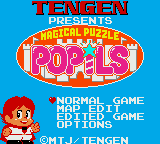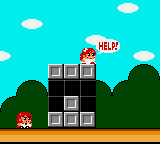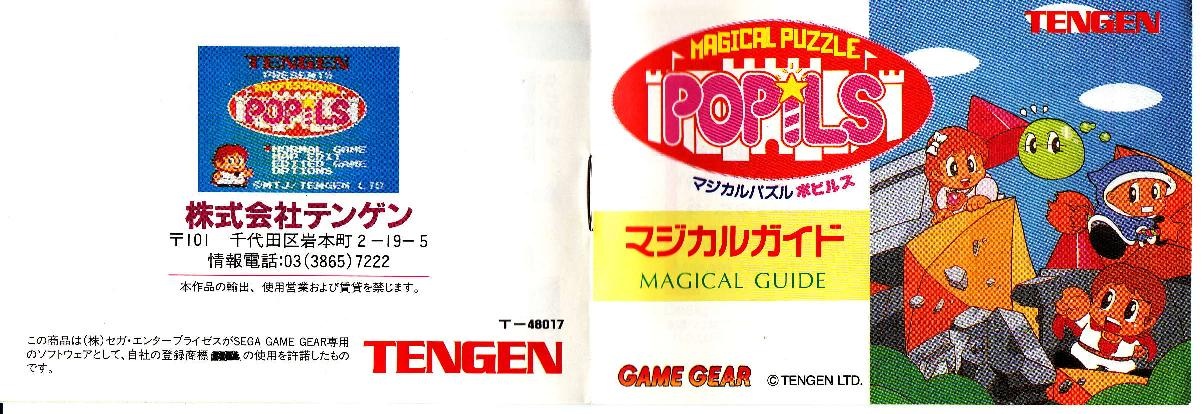Magical Puzzle Popils
From Sega Retro
| Magical Puzzle Popils | |||||||||||||||||||||||||
|---|---|---|---|---|---|---|---|---|---|---|---|---|---|---|---|---|---|---|---|---|---|---|---|---|---|
| System(s): Sega Game Gear | |||||||||||||||||||||||||
| Publisher: Tengen | |||||||||||||||||||||||||
| Developer: Tengen | |||||||||||||||||||||||||
| Distributor: Domark (EU) | |||||||||||||||||||||||||
| Peripherals supported: Gear-to-Gear Cable | |||||||||||||||||||||||||
| Genre: Puzzle[1][2] | |||||||||||||||||||||||||
| Number of players: 1 | |||||||||||||||||||||||||
| Official in-game languages: | |||||||||||||||||||||||||
|
Magical Puzzle Popils (マジカルパズル・ポピルズ), known as Popils: The Blockbusting Challenge in Europe, is a puzzle game for the Sega Game Gear. Different to other Tengen games, it was developed in Japan.
The game was designed by Fukio Mitsuji, who also designed Bubble Bobble and Rainbow Islands for Taito and SegaSonic Bros. for Sega.
Contents
Story
A nameless Boy falls in love with a beautiful Princess. The evil wizard named Popils is jealous and kidnaps her, trapping her inside an enchanted forest. It is up to the Boy to rescue her.
Gameplay
Magical Puzzle Popils is a single-player puzzle game in the form of a platform game. The player controls the Boy through 100 different rounds and must reach the Princess on each one to complete it. Gameplay focuses on destroying blocks, avoiding enemies and spikes, and using various ladders and warp doors to reach the Princess. Each stage is one fixed screen and does not scroll in any direction. A stage is completed when the Boy and Princess meet or failed when either the Boy or Princess is killed. The Boy and Princess have no health and die if they touch an enemy or fall onto a spike.
The Boy can move around the stage by pressing ![]() or
or ![]() . He cannot jump. He destroys blocks by hitting them; either
. He cannot jump. He destroys blocks by hitting them; either ![]() or
or ![]() punch in the direction that the Boy is facing. The Boy punches continuously in one direction by holding
punch in the direction that the Boy is facing. The Boy punches continuously in one direction by holding ![]() .
. ![]() +
+![]() or
or ![]() +
+![]() headbutts a block above the Boy;
headbutts a block above the Boy; ![]() +
+![]() or
or ![]() +
+![]() kicks a block below the Boy. It is possible to punch blocks above the Boy or kick blocks below him while hanging halfway off another block, and this technique is necessary to solve some of the puzzles. The Boy cannot attack enemies.
kicks a block below the Boy. It is possible to punch blocks above the Boy or kick blocks below him while hanging halfway off another block, and this technique is necessary to solve some of the puzzles. The Boy cannot attack enemies. ![]() +
+![]() restarts the puzzle at the cost of a life.
restarts the puzzle at the cost of a life.
When a block is destroyed the column of blocks above it fall down one square and doing this can change the layout of the stage altering possible paths for the Boy, or for the Princess and enemies which move around. On many stages the player must move the Boy for the most part to reach the Princess, but in some stages movement of the Boy is restricted to a small area and the player must make him punch certain blocks to create a path for the Princess to follow to the Boy.
The game tracks the number of steps the player has used to complete the puzzle. Punching/kicking/headbutting once is one step and walking or climbing one square (16 pixels) also counts as one step. After a stage is completed, the game saves the number of steps that the player took and compares it to the number of steps that the mapper took. To complete the game perfectly, all 100 stages must be completed using the same or fewer number of steps as the mapper.
The game includes a battery backup and retains the player's progress (the stages completed and the fewest number of steps taken for each) after the system is powered off. Additionally, the game has a Resume feature, where it saves the state of the current stage so that the player can continue it after the system is powered back on.
The game saves the player's "IQ" score, which is higher if the player completes stages in fewer steps. Stages can be replayed to improve the number of steps taken, but while the game saves the best run, replayed stages do not add to the player's IQ. The player's IQ is also reset if the player runs out of lives. The game saves the top IQ scores.
Modes
Normal Game
In Normal Game mode, there are 100 stages of increasing difficulty. A stage select screen is shown where any available stage can be picked to play but only stages 1-5 are available at first. Completing any four stages unlocks the next five, and they do not have to be completed in any order or in sequence. Thus stages 1-10 are available to play after completing any four stages from 1-5 and stages 1-15 are available when any eight stages are completed until finally all 100 stages are available to play after any 76 stages have been completed. This means that player can choose to skip one stage out of each set of five and still be able to play stage 100.
On the stage select screen, the player can look at all available stages. Uncompleted stages are displayed in grayscale, completed stages are yellow and may be played again. Also displayed is the number of steps the "mapper" or stage designer used to complete the stage and the fewest the player has used, if the stage has been completed. Pressing the ![]() button on the stage select screen reveals a hint as to how the player might go about completing that stage. The hints point the player in the right direction but there is still thought and skill required to complete the stage.
button on the stage select screen reveals a hint as to how the player might go about completing that stage. The hints point the player in the right direction but there is still thought and skill required to complete the stage.
Completing all 100 stages in any number of steps completes the game and show the credits and ending animation sequence. The game then encourages the player to complete each stage perfectly.
After completing the game once, all stages are available to play, though the player may not have completed them all. If the player has completed a stage in the same or fewer number of steps as the mapper, the stage is displayed as "perfect" and colored green on the stage select screen. Whether intentional or not some stages can be completed in fewer steps than the mapper, some by quite a difference. Others require pixel precision and use of movement tricks to equal or beat the mapper step count. When the player has completed all stages perfectly, the credits are shown again with a slightly different ending sequence.
After completing the game perfectly, and viewing the alternative ending, the player is given the chance to continue once more. If the player chooses to continue they're taken to a secret stage, Round 0, which has to be completed using a gameplay trick the player has not seen before in any of the other 100 stages of the game. The player can continue over and over and keep trying to beat Round 0. If the player powers off the console before they complete Round 0 and activates the Resume feature, they will be able to try it again the next time they load the game. If the player is not using the Resume feature or, when prompted, chooses End rather than Continue, there is no way to get back to it during normal gameplay and the game will need to be completed perfectly again.
Map Editor
The game includes a map editor with which the player can create custom stages and test them. Up to 30 stages can be saved on the cartridge. Players can share maps with each other over a Gear-to-Gear Cable.
A stage must feature the Boy and Princess and can have 0-7 enemies. If doors are used, there must be two of each. Note all the normal game stages also follow the same rules. The Japanese manual includes screenshots of a selection of 10 stages that are not otherwise available in the game that can be entered into the map editor and played.
Rounds
- Main article: Magical Puzzle Popils/Maps.
Characters
| Boy | |
|---|---|
| The player character. He must make his way to the Princess. The stage is completed when the Boy touches the Princess. | |
| Princess | |
| The goal of each stage. She moves left and right on top of blocks. When she runs into a block, she changes direction. |
Blocks
Enemies
| Slime | |
|---|---|
| Moves left and right on top of blocks. When it hits an impassable block, it turns around and starts moving in the opposite direction. Kills the Boy or Princess upon contact. | |
| Vampire | |
| Moves left and right between blocks like Slimes but flies. Does not fall when a block beneath it is destroyed (unless there is a block above it). Also kills the Boy or Princess upon contact |
Versions
Developer Jun Amanai has posted videos of several unreleased games on his YouTube channel, including Magical Puzzle Popils for the Famicom and PC Engine.[6] He states that the Famicom version was the original and that all of the puzzles in the Game Gear version were created in the Famicom version's map editor. Only the Game Gear version of the game was ever released.
Localised names
| Language | Localised Name | English Translation |
|---|---|---|
| English | Popils: The Blockbusting Challenge | Popils: The Blockbusting Challenge |
| English (US) | Magical Puzzle Popils | Magical Puzzle Popils |
| Japanese | マジカルパズル・ポピルズ | Magical Puzzle Popils |
Production credits
- Concept & Game Design: Fukio Mitsuji (MTJ)
- Additional Design & Program: Jun Amanai (JUN)
- Music & Sound: Yoshihito Tomuro (TOM)
- Graphics: Ken-ichi Nemoto (KAI), Masato Nagashima (HOD)
- Map Design: Kazuo Matsunaga (MTN)
- Game Design: F.Mitsuji
- Audio: Y.Tomuro
- Graphics: K.Nemoto, M.Nagashima
- Map Design: K.Matsunaga
- Program: Jun Amanai
- Game Design: F.Mitsuji
- Program: Jun Amanai
- Visual: M.Nagashima, F.Mitsuji, K.Nemoto
- Audio: Y.Tomuro
- Map Design: K.Matsunaga, K.Nemoto, F.Mitsuji
Magazine articles
- Main article: Magical Puzzle Popils/Magazine articles.
Promotional material
also published in:
- Beep! MegaDrive (JP) #1992-04: "April 1992" (1992-03-07)[10]
also published in:
- Hobby Consolas (ES) #18: "Marzo 1993" (1993-xx-xx)[11]
- Todo Sega (ES) #1: "Abril 1993" (1993-03-15)[12]
- Micromanía (segunda época) (ES) #59: "Abril 1993" (1993-0x-xx)[13]
Physical scans
| Sega Retro Average | ||||||||||||||||||||||||||||||||||||||||||||||||||||||||||||||||||||||||||||||||||||||||||||||||||||||||||||||||||||||||||||||||||||||||||||||||
|---|---|---|---|---|---|---|---|---|---|---|---|---|---|---|---|---|---|---|---|---|---|---|---|---|---|---|---|---|---|---|---|---|---|---|---|---|---|---|---|---|---|---|---|---|---|---|---|---|---|---|---|---|---|---|---|---|---|---|---|---|---|---|---|---|---|---|---|---|---|---|---|---|---|---|---|---|---|---|---|---|---|---|---|---|---|---|---|---|---|---|---|---|---|---|---|---|---|---|---|---|---|---|---|---|---|---|---|---|---|---|---|---|---|---|---|---|---|---|---|---|---|---|---|---|---|---|---|---|---|---|---|---|---|---|---|---|---|---|---|---|---|---|---|---|
|
| 82 | |
|---|---|
| Based on 28 reviews | |
Technical information
The game will restart as the last level completed with automatic battery backed saves.
The level editor feature allows for the creation and storage of 30 user levels.
ROM dump status
| System | Hash | Size | Build Date | Source | Comments | |||||||||
|---|---|---|---|---|---|---|---|---|---|---|---|---|---|---|
| ✔ |
|
128kB | 199X | Cartridge | 8KB backup |
References
NEC Retro has more information related to Magical Puzzle Popils
|
- ↑ File:Popils GG EU Box Back.jpg
- ↑ 2.0 2.1 http://sega.jp/fb/segahard/gg/soft_licensee.html (Wayback Machine: 2013-01-01 20:24)
- ↑ Beep! MegaDrive, "August 1991" (JP; 1991-07-08), page 12
- ↑ 4.0 4.1 GamePro, "April 1992" (US; 1992-xx-xx), page 76
- ↑ 5.0 5.1 5.2 Computer Trade Weekly, "" (UK; 1992-09-28), page 6
- ↑ https://www.retrogamer.net/blog_post/ex-tengen-coder-reveals-unreleased-games/ (Wayback Machine: 2016-08-03 17:51)
- ↑ File:Magical Puzzle Popils GG JP Manual.pdf, page 2
- ↑ https://youtu.be/jRYj_oE5NGk
- ↑ File:MagicalPuzzlePopils GG JP AltCredits.png
- ↑ Beep! MegaDrive, "April 1992" (JP; 1992-03-07), page 20
- ↑ Hobby Consolas, "Marzo 1993" (ES; 1993-xx-xx), page 29
- ↑ Todo Sega, "Abril 1993" (ES; 1993-03-15), page 2
- ↑ Micromanía (segunda época), "Abril 1993" (ES; 1993-0x-xx), page 2
- ↑ Beep! MegaDrive, "August 1991" (JP; 1991-07-08), page 36
- ↑ Consoles +, "Septembre 1991" (FR; 1991-09-04), page 113
- ↑ Computer & Video Games, "May 1992 (Go! Issue 7)" (UK; 1992-04-15), page 22
- ↑ Gamers, "Dezember/Januar 1993" (DE; 1992-11-19), page 83
- ↑ Game Informer, "Summer 1992" (US; 1992-0x-xx), page 6
- ↑ Game Zone, "April 1992" (UK; 1992-03-20), page 53
- ↑ Game Zone, "October 1992" (UK; 1992-09-24), page 56
- ↑ Hippon Super, "July 1991" (JP; 1991-06-04), page 114
- ↑ Hobby Consolas, "Noviembre 1992" (ES; 1992-xx-xx), page 90
- ↑ Joypad, "Novembre 1992" (FR; 1992-1x-xx), page 150
- ↑ Joystick, "Septembre 1991" (FR; 1991-0x-xx), page 173
- ↑ Joystick, "Décembre 1992" (FR; 1992-1x-xx), page 196
- ↑ Megablast, "4/93" (DE; 1993-09-29), page 100
- ↑ Player One, "Novembre 1992" (FR; 1992-11-10), page 129
- ↑ Play Time, "11/92" (DE; 1992-10-07), page 91
- ↑ Power Play, "12/91" (DE; 1991-11-13), page 179
- ↑ Sega Power, "May 1992" (UK; 1992-04-02), page 46
- ↑ Sega Pro, "August 1992" (UK; 1992-07-16), page 38
- ↑ Sega Pro, "April 1993" (UK; 1993-03-11), page 74
- ↑ Sega Force, "6/93" (SE; 1993-09-30), page 27
- ↑ Sega Force, "September 1992" (UK; 1992-08-13), page 72
- ↑ Sega Saturn Magazine, "September 1995" (JP; 1995-08-08), page 88
- ↑ Supersonic, "Novembre 1992" (FR; 1992-xx-xx), page 27
- ↑ Tilt, "Décembre 1991" (FR; 1991-1x-xx), page 72
- ↑ User, "Aprílios 1993" (GR; 1993-0x-xx), page 50
- ↑ Video Games, "4/91" (DE; 1991-12-06), page 92
- ↑ Zero, "September 1992" (UK; 1992-08-13), page 80
| Magical Puzzle Popils | |
|---|---|
|
Main page | Maps | Hidden content | Magazine articles | Reception | |
- Gear-to-Gear Cable-compatible games
- 1 player games
- JP Game Gear games
- All JP games
- US Game Gear games
- All US games
- EU Game Gear games
- All EU games
- UK Game Gear games
- All UK games
- Game Gear games
- 1991 Game Gear games
- All 1991 games
- Game Gear puzzle games
- All puzzle games
- All games
- Credits without reference
- Old technical information
- Magical Puzzle Popils















